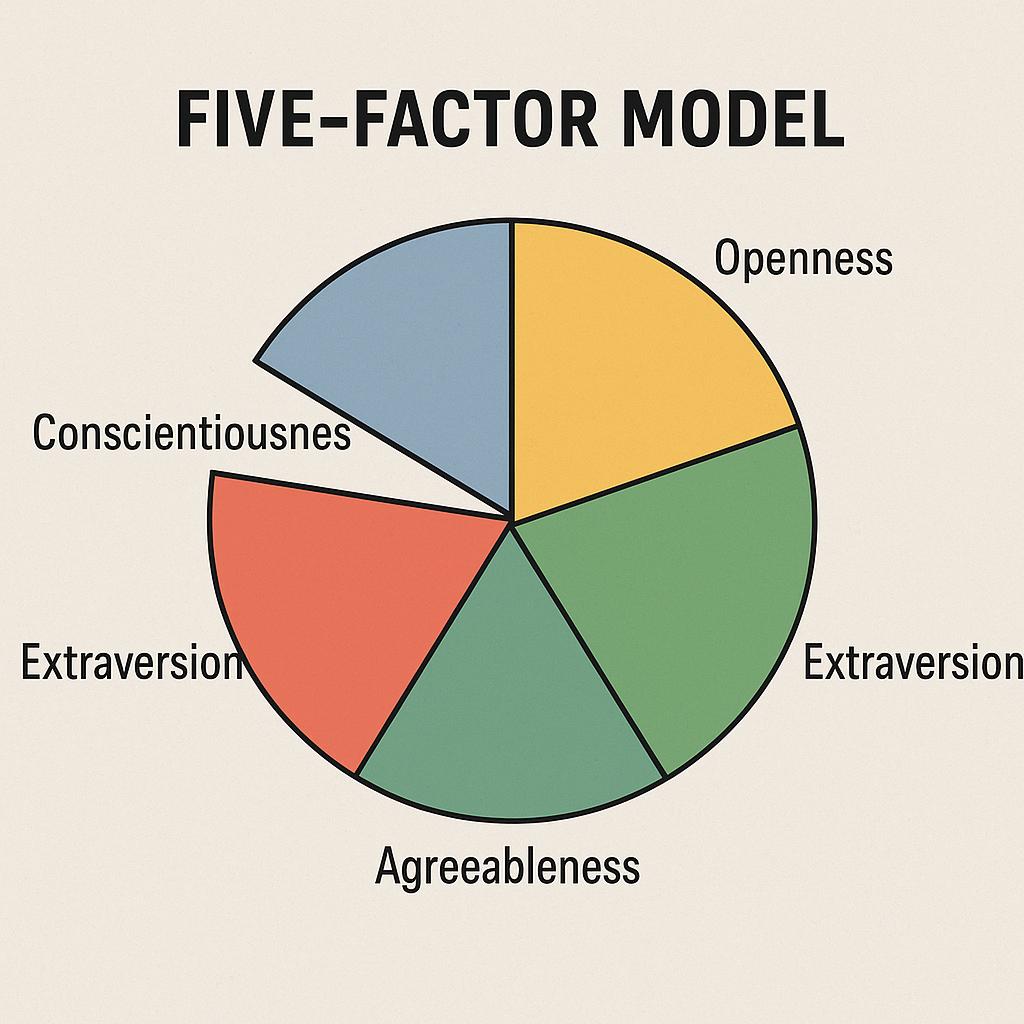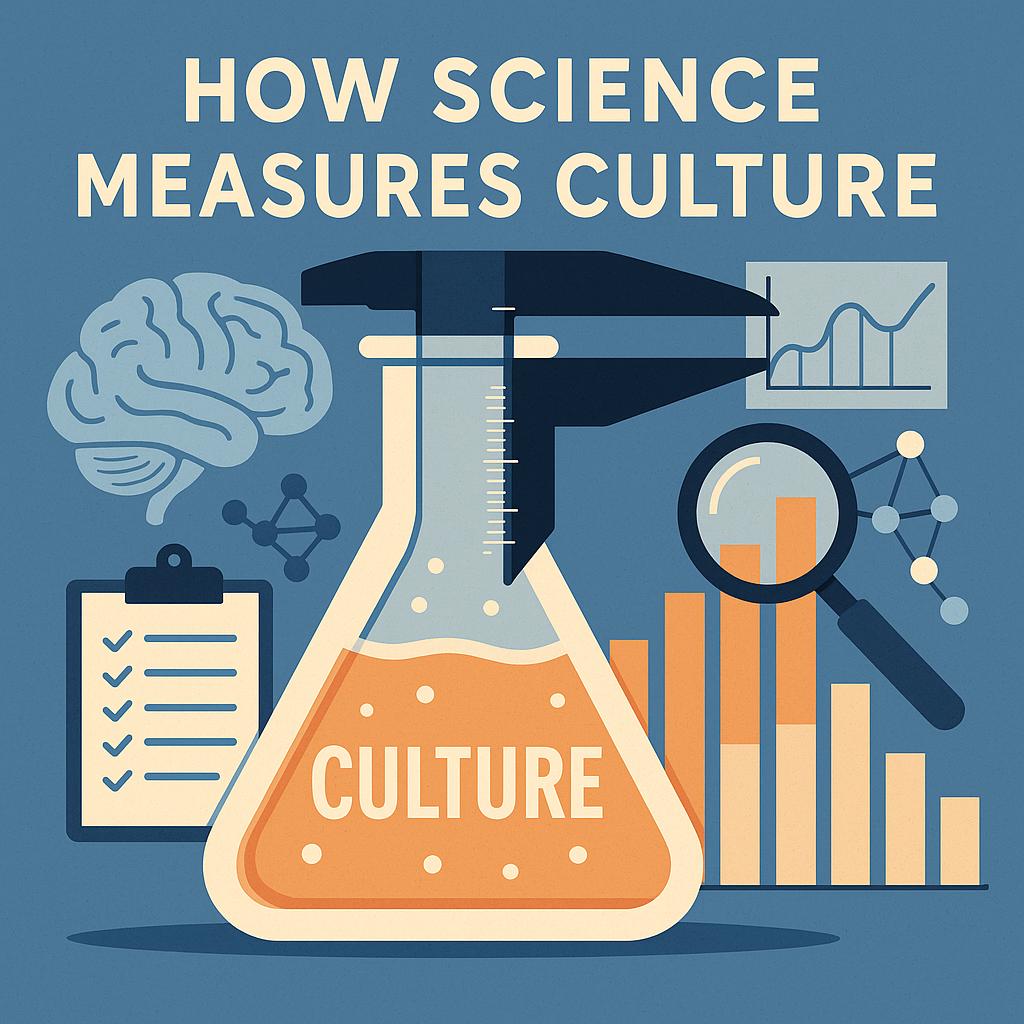Culture is one of the most powerful yet elusive forces shaping human behavior. It guides our values, language, dress, morality, habits, and ambitions. Yet despite its abstract nature, modern science has developed many sophisticated tools for measuring it. Culture is not only observable—it is quantifiable. Across disciplines such as psychology, anthropology, sociology, economics, and neuroscience, researchers are now uncovering ways to study culture with rigor, precision, and empirical clarity. Through these methods, we are beginning to understand not only what culture is—but how it evolves, spreads, changes, and impacts us at every level.
For a long time, I naively believed that culture could not be measured, therefore it didn’t exist. Growing up in the Czech Republic, I had never encountered the concept of cultural metrics. But I was wrong. There are measurable cultural variables even across regions of the same country, including the Czech Republic. Once we start recognizing them, the picture becomes clear: culture can be studied, dissected, compared, and understood scientifically.
1. Defining culture across disciplines
To begin, we must first understand how different fields conceptualize culture:
- Anthropology views culture as the learned behaviors, practices, and traditions passed through generations. This includes rituals, language, diet, kinship, religious ceremonies, and governance systems. Anthropologists stress enculturation—the process by which individuals absorb cultural norms through childhood and socialization. These patterns shape not only daily life but worldview, aesthetics, and moral frameworks.
- Sociology emphasizes macro-level institutions and group dynamics. Culture, in this view, is the invisible code that regulates social interaction, creating norms, roles, status hierarchies, and shared meanings. It sustains collective consciousness and reinforces group boundaries. In Czech society, for example, local attitudes toward authority, alcohol, and gender roles differ by region and class—indicators of internal cultural variation.
- Psychology, especially cultural psychology, focuses on mental schemas and cognitive tendencies shared across communities. These include preferred ways of reasoning, self-construals (independent vs interdependent), emotional display rules, and moral decision-making styles. Cultural values influence everything from how individuals perceive time and space to how they regulate emotion and seek meaning.
- Neuroscience contributes by uncovering how culture shapes the brain. Neural pathways involved in empathy, moral judgment, and self-reflection activate differently depending on one’s cultural background. For instance, collectivist cultures may show more medial prefrontal cortex activity when thinking about family, while individualist cultures show this activity mainly during self-referential tasks.
Five-Factor model

- Education science links learning styles to cultural values. In high-context societies, such as many East Asian cultures, students may perform better in collectivist and hierarchical classrooms. By contrast, Western cultures prioritize Socratic dialogue and individual performance. Curricular design aligned with cultural expectations results in improved comprehension and retention.
- Personality psychology brings the Five-Factor Model into cultural analysis. Researchers have found that certain personality trait distributions are common in particular cultural contexts. For example, East Asian cultures exhibit lower average extraversion and higher conscientiousness—likely reflecting Confucian ideals of modesty and discipline. Latin American societies rank higher in agreeableness and extraversion, supporting stronger interpersonal orientation and expressive communication. Scandinavian countries score high on openness and low on neuroticism, aligning with emotional stability and curiosity, and perhaps linked to their economic development and social trust.
Even economics
- Economics examines how cultural norms impact market behavior. Saving rates, trust in institutions, tax compliance, and even levels of entrepreneurship can all be tied to cultural values. Institutions evolve in tandem with prevailing norms, and successful policy reforms often depend on understanding cultural resistances or predispositions.
- Conflict resolution and diplomacy rely heavily on cultural fluency. Misunderstandings between collectivist and individualist societies, for example, can spark diplomatic rifts or failed peace negotiations. By quantifying dimensions such as power distance, face-saving norms, and attitudes toward uncertainty, intercultural mediators can anticipate flashpoints and adjust strategies accordingly.
- Artificial Intelligence development increasingly integrates cultural awareness. AI systems trained on culturally biased data may misinterpret or mishandle user behavior across different regions. Therefore, culturally sensitive training data sets—respecting variation in communication style, politeness norms, and conceptual metaphors—are critical for safe and equitable AI deployment.
- Development aid must be tailored to cultural contexts. Attempts to transplant Western education or legal models into tribal, hierarchical, or oral cultures often fail without local adaptation. Success lies in identifying which cultural traits promote resilience and can be leveraged to introduce gradual change.
All these domains now rely on precise cultural data—not anecdotes or assumptions. Thus, measuring culture is not a fringe exercise. It is essential for applied science in a globalized world.
2. Quantifying Culture: The Tools
To move from theory to precision, scientists have developed a variety of tools for measuring culture empirically. These tools do not rely on vague impressions or stereotypes. Instead, they gather structured data, apply statistical models, and make meaningful comparisons. Let us examine the main instruments used:
1. Surveys: Hofstede’s Dimensions and Schwartz’s Value Inventory
Two of the most influential survey-based models for measuring cultural differences are Geert Hofstede’s cultural dimensions and Shalom Schwartz’s value inventory. Both models collect national-level data on how people perceive authority, hierarchy, individuality, time, uncertainty, and morality.
Hofstede’s model identifies core cultural dimensions such as:
- Power Distance (acceptance of inequality)
- Individualism vs Collectivism
- Uncertainty Avoidance (tolerance for ambiguity)
- Masculinity vs Femininity (competitive vs nurturing values)
- Long-Term Orientation (future focus vs tradition)
- Indulgence vs Restraint
For example, countries like Japan score high in uncertainty avoidance, reflecting a cultural emphasis on rules and predictability, while the U.S. scores high in individualism.
Schwartz’s model categorizes values into ten universal categories, like self-direction, conformity, tradition, benevolence, or achievement, and maps how strongly each culture prioritizes them. These inventories are administered via large-scale questionnaires, statistically analyzed, and used by governments, businesses, educators, and social scientists worldwide.
These surveys reveal that value systems are not random—they are consistent within populations and shape institutions, expectations, and behaviors across nations.
2. Behavioral experiments: Reactions to the same stimuli
Behavioral experiments are another powerful tool. Here, researchers present participants from different cultural backgrounds with identical tasks, dilemmas, or choices, and then analyze how their responses vary. These studies move beyond self-report and observe culture in action.
For example, researchers might show a short video of a group conflict and ask, “Who is at fault?” or provide a story where a person must choose between loyalty to family or honesty to the state. Westerners may prioritize individual conscience, while East Asians may emphasize group harmony.
Other experiments examine risk-taking, trust, cooperation, or generosity using games like the Prisoner’s Dilemma or Ultimatum Game. These behaviors vary systematically across cultures, offering insight into economic behavior, legal systems, or even public health compliance.
What makes behavioral experiments powerful is that they isolate cultural cognition from verbal justification. People show their values through actions—not just words.
3. Linguistic analysis: How language mirrors culture
Language both reflects and shapes culture. Linguistic analysis, whether computational or ethnographic, explores how grammatical structures, metaphors, and vocabulary reveal cultural priorities.
For example, some languages encode respect directly into verb conjugations (like Korean or Japanese), enforcing hierarchy and formality in daily speech. Others, like English, tend to be more egalitarian and expressive.
Metaphor usage is another cultural marker. English speakers often describe time horizontally (“looking forward to the weekend”), while Mandarin speakers may use vertical metaphors (“the month below”). These habits influence how people visualize and reason about abstract concepts like time or morality.
Modern tools like corpus linguistics and natural language processing (NLP) allow massive textual datasets—tweets, speeches, novels, news—to be analyzed for cultural tone, moral framing, political polarization, and emotional register. Language becomes a measurable cultural signal, not just a tool for communication.
4. Cognitive neuroscience: Imaging culture in the brain
Neuroscience adds a remarkable layer of depth. Using technologies like fMRI (functional magnetic resonance imaging) and EEG (electroencephalography), scientists can observe how brain activity differs between individuals raised in distinct cultural settings.
Studies have shown that East Asian participants exhibit more activation in brain regions associated with social context and interdependence, especially when reflecting on moral decisions or family identity. Western participants, in contrast, show more activation in areas associated with individual agency and self-definition.
Cultural values literally leave neural footprints. Even perception changes: studies found that Americans tend to focus more on foreground objects, while Japanese participants notice background and context—mirroring holistic vs analytical thinking styles.
This field proves that culture is not just in minds—it is in brains, reshaped by environment and repeated social patterns.
5. Econometrics: connecting culture to economic outcomes
Finally, econometrics provides a bridge between cultural psychology and real-world impact. Economists now examine how cultural values—measured through surveys and behavioral data—predict outcomes such as:
- Savings rates
- Tax compliance
- Innovation levels
- Trust in institutions
- Corruption perception
- Entrepreneurship rates
For example, societies that value long-term orientation tend to have higher savings and investment rates. High uncertainty avoidance might correlate with risk-averse policies or rigid education systems.
By integrating cultural variables into econometric models, scholars can isolate the effect of values from that of GDP, demographics, or natural resources, revealing how deeply culture shapes success or failure at the societal level.
Scientific assessment of cultural profiles: Ten societies compared
Culture is not static folklore—it is an evolving system of cognition, values, behavior, and social interaction. Each culture shapes how individuals perceive the world, respond to authority, trust others, learn, and even use their brains. Scientific tools—from psychometrics to behavioral experiments and neural imaging—now allow us to examine and compare cultures with precision. In this article, we assess ten different cultures through the lens of empirical science.
1. Italian culture: Expressive individualism within strong collectivism
Italy exhibits a fascinating blend of expressive communication and deep-rooted familial collectivism. Surveys such as Hofstede’s place Italy moderately high in individualism, but day-to-day life reflects strong family orientation and loyalty-based networks—often linked to patronage and regional identities.
- Extraversion and agreeableness tend to be high, promoting warmth, social vibrancy, and hospitality.
- However, trust outside close social circles remains low, leading to challenges in state functioning and high perceived corruption.
- Emotion is openly expressed—both positive and negative—which helps resolve tension quickly but fosters occasional volatility.
- Linguistically, metaphors and expressiveness dominate. Conversations are high-context and intuitive.
Behavioral studies suggest that Italian cultural cognition values beauty, improvisation, and negotiation over rule adherence—reflected in both bureaucracy and business culture.
2. American culture: High individualism, low power distance
The United States remains one of the most individualistic cultures on Earth. From early childhood, the cultural script emphasizes autonomy, success, and personal responsibility. This shows up in educational styles, media, politics, and interpersonal behavior.
- Personality assessments often find Americans high in openness and extraversion, but also moderate to high in neuroticism compared to more emotionally stable cultures.
- The U.S. ranks low in power distance—people expect to be treated equally regardless of status.
- Business and academic environments foster competition and achievement, reinforced by Darwinian metaphors and frontier ideology.
Cognitive neuroscience shows strong activation in brain regions associated with personal agency and independence, especially when compared to East Asian cultures.
At the same time, low collectivism produces weak social safety nets, atomized communities, and loneliness. Behavioral experiments confirm a preference for individual rights even at the cost of group cohesion.
3. Japanese culture: Collectivist precision and self-suppression

Japan presents an opposite model: high collectivism, high uncertainty avoidance, and strong long-term orientation. Japanese society favors group harmony, procedural order, and emotional regulation.
- Individuals score lower on extraversion and openness, but very high on conscientiousness and agreeableness.
- Honor and face-saving guide behavior; shame is a stronger motivator than guilt.
- High-context communication relies on implicit cues, silence, and shared social understanding.
- Neuroscientific studies show enhanced activity in social monitoring areas when evaluating one’s actions.
Education emphasizes discipline and hierarchy. Innovation exists, but within institutional rules. Personal desires are subordinated to group stability.
4. Scandinavian culture: Openness, trust, and emotional stability
Nordic countries like Sweden represent a unique blend of individualism and egalitarian collectivism. Citizens are encouraged to be self-reliant, but state institutions provide extensive support.
- High scores in openness, agreeableness, and emotional stability make Scandinavians calm, tolerant, and innovative.
- Power distance is extremely low; CEOs bike to work and teachers are addressed by first names.
- High societal trust enables low corruption and smooth cooperation.
Behavioral economics confirms that Swedes exhibit high public goods contributions, robust civic responsibility, and long-term decision-making.
5. Chinese culture: hierarchy, harmony, and conformity
China scores high on power distance, collectivism, and long-term orientation, but low on uncertainty tolerance. This produces a culture that values hierarchy, education, self-discipline, and economic achievement.
- Personality traits skew toward low extraversion and high conscientiousness.
- Emotional expression is muted; direct confrontation is avoided.
- Language is rich in relational nuance and implicit meaning.
- fMRI studies show stronger brain responses to relational tasks and family-associated memory retrieval.
While innovation is growing, systemic pressure to conform and the suppression of dissent remain cultural obstacles.
6. Brazilian culture: Emotional warmth with norm ambiguity
Brazil is marked by high extraversion, emotional expressiveness, and strong family orientation, mixed with a relatively high tolerance for ambiguity and informality.
- Brazilians score high on agreeableness and neuroticism, suggesting emotional openness and interpersonal sensitivity.
- Social interaction is key: from greetings to business deals, relationship-building is paramount.
- Trust in institutions is low, but informal support networks are strong.
- Cultural values prize joy, rhythm, improvisation, and charisma.
Linguistically and behaviorally, Brazilians exhibit high-context styles. Rules often yield to flexibility, creating challenges for governance but strength in personal resilience.
7. Russian culture: Endurance, mistrust, and philosophical depth
Russia blends collectivist tendencies with high power distance and long-term orientation. Russians tend to score high in neuroticism and conscientiousness, shaped by historical turbulence and cultural emphasis on endurance.
- Trust is limited to close personal networks, with low trust in institutions and the public sphere.
- Philosophical and literary traditions are strong, often emphasizing suffering, depth, and fate.
- Communication is formal and emotionally layered; sarcasm and irony are common.
- Behavioral economics finds higher tolerance for ambiguity and fatalism compared to Western norms.
Institutions are opaque, and corruption is endemic. However, creativity, survivalism, and geopolitical strategic thinking remain cultural strengths.
8. German culture: Rule-conscious, precise, and low-context
Germany is a rule-based, low-context, and precision-oriented society. Germans tend to score high in conscientiousness and lower in agreeableness, reflecting a preference for accuracy and systematization over emotional expressiveness.
- Cultural values emphasize punctuality, logic, and reliability.
- Institutions are designed to minimize uncertainty—Germany scores high on uncertainty avoidance.
- Communication is direct but respectful. Debate and critique are part of intellectual culture.
Behavioral studies show that Germans prioritize long-term planning and trust formal systems over personal networks. Emotional regulation is high; professionalism often overrides social warmth.
9. French culture: Intellectual elegance and complex authority
France combines individualism with strong state tradition. The French score high in openness and neuroticism, reflecting cultural appreciation for nuance, debate, and critique.
- Institutions are hierarchical but ideologically rich, shaped by republican and enlightenment values.
- Communication is rhetorical, abstract, and expressive.
- Artistic, culinary, and philosophical traditions reinforce national pride and aesthetic excellence.
French society celebrates rebellion and tradition simultaneously. High uncertainty avoidance fosters systemic rigidity, but cultural flexibility persists through satire and public discourse.
10. British culture: Reserved expression and layered identity

British culture is marked by a complex mix of individualism, institutional tradition, and understated social norms. Surveys consistently place the United Kingdom high in individualism, yet with a unique emphasis on decorum, self-restraint, and irony as modes of social cohesion.
- Emotional expression is often muted. The “stiff upper lip” reflects cultural values of endurance, stoicism, and dignity in adversity.
- Politeness and indirect communication are not mere courtesies—they serve as social buffers in a densely stratified society.
- The British score moderately high in conscientiousness and agreeableness, but lower in extraversion, reflecting a culture that values privacy and subtlety.
- Hierarchies are formalized but softened by humor, satire, and gradualism. Deference is often masked by informal conventions (e.g., calling managers by first names), but social class remains a powerful subtext in daily interactions.
Reserved
Linguistically, British English favors understatement and irony. Phrases like “not bad” may mean excellent, while “interesting” may signal disapproval. This layered communication style rewards cultural insiders and can frustrate outsiders unfamiliar with its coded nuance.
Behavioral studies suggest that British civic life operates through a stable balance of tradition and quiet reform. Trust in institutions like the BBC, NHS, or monarchy—though fluctuating—is rooted in historical continuity rather than emotional nationalism.
Neuroscientific research shows that British participants exhibit greater neural response to social norm violations in public settings, supporting the hypothesis that conformity and face-saving are subtly enforced even in individualist societies.
At the same time, the UK is far from monolithic. Scottish, Welsh, Irish, and regional English identities differ sharply. London itself is a multicultural hub where accents, cuisines, and customs blur any fixed notion of Britishness.
The British tradition of satire—from Shakespeare to Monty Python—functions not just as entertainment, but as a cultural pressure valve. This allows criticism of power without direct confrontation, preserving harmony while enabling social evolution.
Altogether, British culture embodies paradox: emotionally restrained yet deeply poetic, socially hierarchical yet officially egalitarian, globally influential yet often self-deprecating. Its quiet complexity resists simplification—and rewards those who read between the lines.
Certainly. Here is a cultural profile of Ashkenazi Jewish culture in the same analytical and stylistic format:
Plus: Ashkenazi Jewish culture: Intellectual resilience and ethical complexity
Ashkenazi Jewish culture, shaped by centuries of diaspora life in Central and Eastern Europe, blends intense intellectual tradition with adaptive collectivism. It is marked by high openness, high conscientiousness, and a cultural emphasis on learning, moral reasoning, and survival under pressure.
- Institutions are traditionally community-based—yeshivas, synagogues, mutual aid societies—rather than hierarchical states, emphasizing moral authority over formal rank.
- Communication is rich in argumentation, irony, and layered text—whether in Talmudic debate, philosophical discourse, or storytelling.
- Education is central. Intellectual achievement is revered, with Torah study historically considered a sacred duty, even among the poor.
- Cultural values encourage questioning, dissent, and dialectics rather than passive acceptance. “Two Jews, three opinions” reflects a deep-rooted norm of debate over dogma.
Ashkenazi identity was forged under exclusion, pogroms, and displacement, fostering strong in-group solidarity, humor as a coping mechanism, and deep concern for justice and memory.
Psychological studies show high verbal IQ averages and emphasis on delayed gratification—traits likely amplified by cultural selection pressures over generations. Social trust outside the group may be cautious due to historical trauma, but internal networks are often dense, supportive, and intellectually vibrant.
While modern assimilation varies, echoes of Ashkenazi culture persist in literature, science, law, and activism—often balancing cosmopolitan ethics with particular historical memory. This duality, between globalism and survival, intellect and vulnerability, remains the heart of Ashkenazi cultural identity.
Avoid stereotyping
Cultural stereotypes are mental shortcuts—often inaccurate, overly generalized beliefs about entire groups. They may seem harmless, but in reality, they distort perception, fuel prejudice, and create barriers to genuine understanding. In an era of globalization and intercultural contact, moving beyond these simplistic narratives is not just ideal—it is essential.
Stereotypes often arise when limited exposure to a group is exaggerated into a defining image. For example, assuming all Italians are loud, all Japanese are obedient, or all Americans are individualistic misses the deep diversity within each culture. These tropes ignore regional, social, economic, and individual variation. A southern Italian may differ significantly from a northern one, just as a Californian differs from a Midwesterner. Culture is not monolithic; it is dynamic and multifaceted.
Scientific data contradicts many stereotypes. Personality studies, for instance, show variation within cultures that often exceeds the differences between them. While Brazilians may score higher in extraversion, this does not mean every Brazilian is outgoing. While Japanese culture favors social harmony, individual personalities still range from assertive to introverted. Neuroscience also reveals that environmental context, upbringing, and social networks can shape cognition and emotional regulation in ways that differ vastly even within the same country.
Historical context is also key. Stereotypes evolve from colonial narratives, propaganda, and conflict. For instance, German rigidity, British coldness, or French arrogance are products of historical friction, not inherent truths. The media plays a crucial role in reinforcing such caricatures, often favoring simplistic portrayals over nuanced realities. Cartoons, films, news cycles, and social media memes often reduce entire nations to symbolic behaviors, robbing people of their complexity and individuality.
Science vs stereotypes
Jewish stereotypes have long been weaponized through history, often depicting Jews as overly intellectual, financially cunning, or clannish. These reductive views ignore the immense cultural, geographic, and philosophical diversity within Jewish communities—from secular liberals in the U.S. to Orthodox scholars in Israel. Worse, these stereotypes have been historically linked to discrimination, forced displacement, and violence. Antisemitism has taken the form of conspiracy theories, scapegoating during economic crises, and exclusion from civic life, despite Jews’ significant contributions to science, art, and philosophy across centuries.
Irish stereotypes typically portray people as heavy drinkers, jovial, or prone to fighting. These tropes, rooted in 19th-century British propaganda, have persisted despite modern Ireland’s transformation into a literate, innovative society. The Irish diaspora includes intellectuals, artists, civic leaders, and businesspeople whose lives defy such narrow labels. The framing of Irish identity as unruly or backward was historically used to justify colonial control and cultural suppression, further illustrating how stereotypes serve political as well as psychological functions.
To overcome stereotyping, one must embrace empirical evidence, cross-cultural education, and deep listening. Engage with primary sources—literature, films, art—from within a culture. Speak with individuals rather than about groups. Recognize that all cultures are internally plural, historically shaped, and constantly evolving. Anthropology teaches us to observe with humility. Psychology reminds us that we project our biases. Sociology reveals the structural power behind labeling. Only through interdisciplinary insight can we dismantle the comfort of easy assumptions.
Stereotypes comfort the mind by reducing complexity. But true understanding begins where simplification ends. Only by resisting the urge to categorize can we approach the depth and dignity of human difference. Celebrating culture requires rejecting clichés. It demands intellectual rigor, empathy, and the courage to question even our most familiar beliefs.
Conclusion: Toward a science of culture
Culture is not mystical, mythical, or beyond analysis. It is structured, predictable, and measurable. As science continues to refine its instruments—from behavioral games to neural imaging—we move closer to a full understanding of how humans build meaning, identity, and institutions across generations.
What began as folklore and tradition now enters the lab and statistical model. We now have the tools to explain why Czech punctuality differs from Brazilian spontaneity, why Japanese formality contrasts with American directness, and how values shape everything from brain circuits to tax codes.
To ignore culture is to ignore the operating system of society. But to measure it—scientifically, precisely, and respectfully—is to unlock the next frontier of global understanding.

Leave a Reply